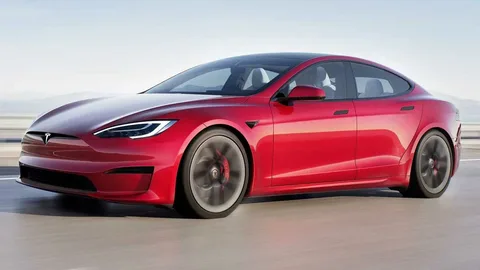Tesla, the electric vehicle (EV) pioneer founded by Elon Musk, has revolutionized the automotive industry with its advanced electric cars. From the Model S to the Model 3, Model X, and Model Y, Tesla vehicles have consistently raised the bar in terms of performance, safety, and efficiency. However, one of the most significant factors influencing these attributes is the weight of the vehicle, which plays a crucial role in determining the car’s performance, efficiency, handling, and overall driving experience.
In this blog, we will explore how the weight of a Tesla car affects various aspects of its performance and efficiency. We’ll also dive into the reasons why Tesla’s weight is both a challenge and an advantage, and how the company has managed to innovate around this factor.
Understanding Tesla’s Weight
Before diving into the specifics, it’s important to understand what makes up the weight of a Tesla. Like any other vehicle, a Tesla’s weight is influenced by various components, including:
- Battery Pack: The most significant contributor to a Tesla’s weight is the battery pack. Electric vehicles (EVs) require large batteries to store and provide the power necessary for driving. Tesla’s lithium-ion battery packs are heavy, and the size of the battery pack varies based on the model and the range desired. For instance, a higher range typically means a larger, heavier battery.
- Electric Motors: Teslas use high-performance electric motors, which, while compact and efficient, do add to the vehicle’s overall weight compared to traditional internal combustion engine (ICE) vehicles.
- Chassis and Body: Tesla uses lightweight materials such as aluminum and high-strength steel to construct the body and chassis of its vehicles. This reduces weight but still keeps the vehicle durable and safe. However, even with these materials, the structure can still be relatively heavy compared to traditional vehicles.
- Other Components: Components like the suspension system, wheels, and interior fittings contribute to the overall weight. Tesla has incorporated advanced features such as autopilot sensors, cameras, and high-tech displays, which add weight as well.
While weight is a critical factor in the overall design of the vehicle, it is not only about how much the car weighs but also how weight is distributed within the car. The strategic placement of the battery pack (underneath the cabin, low to the ground) enhances stability and handling. This aspect of design is key to the performance of a Tesla.
How Weight Affects Tesla’s Performance
1. Acceleration
One of the most widely praised features of Tesla vehicles is their incredible acceleration. Tesla cars, particularly the high-performance models such as the Model S Plaid, can accelerate from 0 to 60 mph in a matter of seconds, outperforming even many sports cars. But how does weight impact this?
In simple terms, the heavier the vehicle, the more energy is required to accelerate it. However, Tesla’s electric motors are highly efficient, and their instant torque allows them to deliver power effectively despite the vehicle’s weight. The Model S Plaid, for example, weighs about 4,800 pounds but can still reach 60 mph in under 2 seconds, thanks to its three electric motors and sophisticated powertrain.
On the other hand, weight can still impact a car’s overall acceleration when it comes to slower speeds. While Teslas are still faster than many conventional cars, the heavier weight can reduce the initial response, especially when compared to lighter sports cars or electric cars with smaller batteries and motors.
2. Handling and Stability
Weight also plays a role in the handling and stability of a vehicle. Heavier cars generally have a more stable feel at higher speeds because they tend to have lower centers of gravity. Tesla has strategically positioned its battery packs low within the frame of its vehicles, which lowers the center of gravity and improves handling.
This is why Teslas, even the larger Model X SUV, are often praised for their sharp handling and impressive cornering capabilities despite their relatively heavy weight. The battery placement also helps reduce body roll when cornering, making Teslas feel more agile and responsive on the road than one might expect from their weight.
That said, heavier vehicles can still face some trade-offs in handling, especially when the roads are slippery or in tight cornering scenarios. The performance of the Tesla vehicle is also contingent on its suspension system and how well the car’s weight distribution is balanced.
3. Braking Performance
A heavier vehicle typically requires more braking power to come to a stop. Tesla’s vehicles are equipped with powerful regenerative braking systems, which not only help conserve energy but also provide strong braking performance. The heavier weight of a Tesla means that more braking force is needed, but Tesla’s use of advanced braking technologies, such as carbon-ceramic brakes in the high-performance models, ensures that the braking distance remains competitive with lighter sports cars.
Additionally, the regenerative braking system in Teslas means that when the driver eases off the accelerator pedal, the electric motors act as brakes, recovering energy and sending it back to the battery. This system works effectively regardless of the vehicle’s weight, ensuring smooth deceleration and greater energy efficiency.
Weight and Tesla’s Efficiency
Tesla’s reputation for efficiency is a key selling point of its vehicles. With a focus on providing long-range EVs, the efficiency of each model is determined by a variety of factors, with weight being one of the most influential.
1. Energy Consumption
Energy consumption in electric vehicles is measured in kilowatt-hours per 100 miles (kWh/100 miles). A lighter car typically consumes less energy because there’s less mass to move, meaning the vehicle doesn’t require as much power to travel the same distance. However, Tesla mitigates the effect of its heavier weight by optimizing the efficiency of its electric motors and battery systems.
For example, the Tesla Model 3, which weighs between 3,500 and 4,000 pounds depending on the configuration, offers a range of 250 to 350 miles on a single charge. Its energy consumption is optimized through advanced aerodynamics, lightweight materials, and a highly efficient powertrain. The Model S, while heavier at over 4,600 pounds, can still achieve impressive range and efficiency, thanks to the efficiency of the dual-motor system and the aerodynamic design of the vehicle.
2. Range and Weight
The relationship between weight and range is straightforward: heavier cars tend to have lower range because they require more energy to move. However, Tesla’s commitment to improving battery technology has allowed them to develop larger, more efficient battery packs, which offset the increased weight. The efficiency of Tesla’s powertrains also helps the vehicles make the most out of every charge, further improving the driving range.
For instance, while a heavier vehicle such as the Model X may have a slightly lower range than the lighter Model 3, both vehicles are still capable of achieving over 300 miles of driving on a single charge in their long-range versions.
3. Charging Efficiency
The weight of the vehicle also plays a role in how efficiently it can charge. Heavier vehicles typically require more power to charge, but Tesla has optimized its Supercharger network and onboard charging systems to accommodate these demands. The weight of the vehicle does not substantially impact the time it takes to charge; instead, charging time is more closely tied to the size of the battery and the type of charging infrastructure used.
Tesla’s Innovations Around Weight
Despite the challenges presented by weight, Tesla has continued to innovate, finding ways to keep weight down without sacrificing performance or safety. Here are a few ways Tesla has addressed the issue of weight in its vehicles:
- Use of Lightweight Materials: Tesla has prioritized using lightweight yet durable materials, such as aluminum and carbon fiber, in the construction of its vehicles. These materials help to reduce weight without compromising safety or strength.
- Battery Technology: Tesla is constantly improving its battery technology, making batteries more energy-dense and lighter. Newer battery designs, such as the 4680 battery cells, are expected to reduce both cost and weight while improving efficiency and range.
- Design Optimizations: Tesla’s vehicles are designed with aerodynamics in mind, helping to reduce drag and increase efficiency. This design philosophy allows for greater range without needing to increase battery size or weight.
Conclusion
The weight of a Tesla car plays a significant role in its performance, handling, and efficiency. While heavier vehicles generally require more energy to accelerate and consume more power for long-distance travel, Tesla has expertly engineered its vehicles to balance weight with cutting-edge performance and energy efficiency. Through the use of advanced materials, efficient powertrains, and innovative battery technologies, Tesla has successfully mitigated the challenges of weight, ensuring that its vehicles offer the best of both worlds: impressive acceleration, long-range capability, and a smooth, enjoyable driving experience.
As Tesla continues to push the boundaries of electric vehicle technology, it is likely that we will see even more advancements aimed at reducing weight while maintaining the brand’s hallmark performance and efficiency. The ongoing evolution of electric vehicles means that the influence of weight on performance will continue to be a key factor in shaping the future of EVs.






